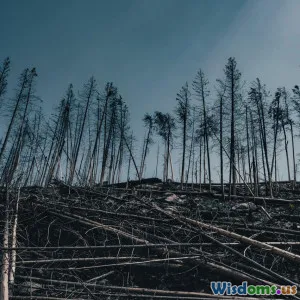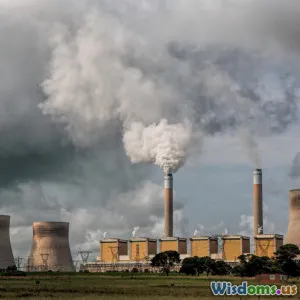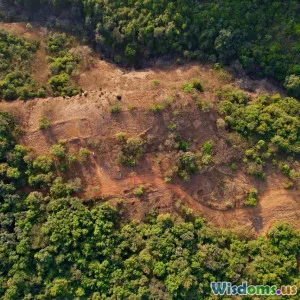
Is Bamboo the Solution to the Deforestation Crisis
9 min read Exploring bamboo's potential as a sustainable solution to combat deforestation and restore ecosystems worldwide. (0 Reviews)
Is Bamboo the Solution to the Deforestation Crisis?
Introduction
The sweeping forests that blanket our planet have long been deemed the lungs of Earth, vital for climate regulation, habitat preservation, and countless ecological functions. Yet, deforestation—the large-scale clearing of these forests—is a mounting crisis threatening biodiversity, accelerating climate change, and jeopardizing livelihoods worldwide. Is there a silver bullet to this problem? Intriguingly, bamboo—a plant often overlooked or relegated to subcategories of grass—holds promising potential as a solution. Could this resilient, fast-growing species be the ecological and economic powerhouse that helps remedy some of the damage caused by deforestation?
This article dives deep into the relevance of bamboo in the context of deforestation, its ecological benefits, real-world applications, and the challenges it presents. By exploring scientific data, current implementations, and expert opinions, we unveil whether bamboo could indeed be a vital tool in the fight against forest loss.
Understanding the Deforestation Crisis
The Scale and Impact
According to the Food and Agriculture Organization (FAO) of the United Nations, we lose approximately 10 million hectares of forest annually—an area roughly the size of Iceland. Deforestation primarily stems from agricultural expansion, logging, and infrastructure development. This loss has multifaceted consequences:
- Carbon Emissions: Forests store about 289 gigatons of carbon in their biomass; clearing them releases vast amounts of greenhouse gases.
- Biodiversity Loss: Forests are home to over 80% of terrestrial species; their destruction threatens countless plants and animals.
- Community Livelihoods: Indigenous and local communities depend heavily on forests for food, medicine, and income.
Consequently, sustainable alternatives and restoration strategies are urgently needed.
Existing Forest Restoration Efforts
Global initiatives like the Bonn Challenge, aiming to restore 350 million hectares by 2030, emphasize tree planting and ecosystem rehabilitation. While tree-based restoration is pivotal, challenges such as slow growth rates, monocultures, and poor soil quality often hinder these projects' success. Against these constraints emerges a feasible option: bamboo.
Bamboo: The Underrated Ally
Botanical Profile and Growth Advantages
Bamboo, a group of perennial evergreens in the grass family Poaceae, comprises over 1,400 species. Some notable advantages make bamboo a prime candidate in environmental restoration:
- Rapid Growth: Bamboo is one of the fastest-growing plants on Earth. Certain species, like Phyllostachys edulis, can grow up to 91 cm (35 inches) in a single day.
- High Yield: Bamboo can be harvested sustainably every 3-5 years, compared to 20-50 years for hardwood trees.
- Minimal Chemical Input: It requires little fertilizer or pesticides.
Ecological Benefits
- Soil Stabilization: Bamboo's dense root mat helps curb soil erosion, a major issue in deforested regions.
- Carbon Sequestration: Studies suggest bamboo can absorb carbon dioxide at rates comparable to or exceeding some tree species.
- Biodiversity Support: Bamboo forests provide habitats to numerous species, such as the iconic giant panda.
Case Study: China's Bamboo Boom
China has extensively utilized bamboo for construction, textile fibers, and reforestation over the past few decades. The country's success demonstrates bamboo’s dual role in economic development and environmental protection. According to China's National Forestry and Grassland Administration, bamboo forests cover over 7.2 million hectares, supporting livelihoods and reducing pressure on traditional timber.
Bamboo in Practical Applications Against Deforestation
Sustainable Construction Material
Bamboo’s tensile strength rivals steel in certain contexts, making it an excellent building material. Its use in sustainable architecture is expanding worldwide, with projects ranging from emergency housing to luxury resorts promoting low-impact development.
Preventing Illegal Logging
By offering an alternative resource easily replenished, bamboo cultivation can reduce dependency on hardwood timber. For example, in countries like Nepal and India, community bamboo farming projects have been implemented to mitigate illegal logging activities by providing income through bamboo products.
Supporting Circular Economies
Bamboo can be transformed into numerous products, such as furniture, paper, bio-composites, clothing fibers, and charcoal. This versatility creates a market-driven incentive to maintain bamboo plantations over destructive logging.
Environmental Rehabilitation
Bamboo plantations can reclaim degraded lands, improving soil health and serving as biological corridors for wildlife. This is particularly relevant in tropical regions where deforestation has left soil eroded and barren.
Challenges and Limitations
While bamboo holds promise, it is not without challenges:
- Monoculture Risks: Large-scale bamboo monocultures risk biodiversity loss if not managed with ecological diversity in mind.
- Invasive Tendencies: Some bamboo species can become invasive outside their native range, potentially outcompeting local flora.
- Market Development: To incentivize bamboo cultivation, consistent market demand and technical know-how for product processing must scale globally.
Moreover, bamboo should complement—not replace—tree conservation efforts. Diverse forest ecosystems provide unique benefits that bamboo-only landscapes cannot fully replicate.
Expert Opinions
Dr. Sandra Díaz, a renowned ecologist, notes: "Bamboo’s extraordinary growth and carbon storage capacity provide a rare opportunity to marry ecological restoration with human economic needs. We must invest wisely to optimize its benefits in a balanced manner."
Similarly, the World Bamboo Organization highlights bamboo’s role in the United Nations Decade on Ecosystem Restoration, underscoring its capacity to bring ecological and socioeconomic gains in tandem.
Conclusion
Deforestation remains one of the gravest threats to our planet’s health, demanding multifaceted solutions grounded in ecological wisdom and economic feasibility. Bamboo, with its rapid growth, sustainability, and versatility, emerges as a compelling tool in mitigating forest loss, restoring degraded lands, and providing alternative livelihoods.
However, harnessing bamboo's full potential requires an integrated approach that addresses challenges related to ecological balance, market structures, and local engagement. It should be viewed not as a panacea, but a powerful complementary strategy alongside conventional forest conservation and restoration efforts.
In envisioning a future where bamboo grows alongside native forests, communities thrive, and ecosystems rebound, bamboo offers more than just a plant—it offers hope. It beckons policymakers, environmentalists, and entrepreneurs to invest in innovation, education, and stewardship for a greener, more resilient planet.
References:
- Food and Agriculture Organization of the United Nations (FAO), Global Forest Resources Assessment 2020
- The World Bamboo Organization: https://worldbamboo.net/
- Research article by Scurlock et al., "Bamboo: an overlooked biomass resource?" Global Change Biology, 2000
- National Forestry and Grassland Administration of China: http://english.forestry.gov.cn/
- United Nations Decade on Ecosystem Restoration (2021-2030): https://www.decadeonrestoration.org/
Rate the Post
User Reviews
Popular Posts





















